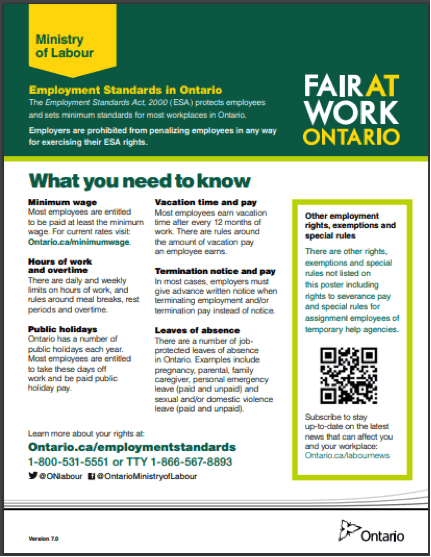
It seems no matter which direction we turn these days change just keeps a comin’! In 2018, Ontario employers have faced a number of new challenges – more than just an increase in minimum wage – arising from the Fair Workplaces, Better Jobs Act, 2017 … better known as “Bill 148”. To help navigate the newest maze of changes affecting workplaces, we have summarized many of the changes employers need to be aware of along with actions you may wish to implement as part of your planning process on how to incorporate some of these changes.
| 1. | Misclassification: | Action |
| Employers can no longer misclassify an employee as a non-employee. | To avoid misidentifying an employee as a non-employee, employers must undertake in in-depth review of any agreements they have with non-employees, such as independent contractors, to mitigate their risk. With legislation constantly being updated, it’s in the employer’s best interest to seek legal advice when necessary. | |
| 2. | Equal Pay for Equal Work: | Action |
| Instead of establishing distinct pay-grades, employers pay employees the same wage for performing the same kind of work for the organization. | Employers should update compensation policies and procedures to ensure they are following legislation, as well as clarify job descriptions to appropriately reflect pay grades. A step and grid framework for progression as well as regular performance reviews will be necessary in order to document and justify differentials in employee wages. | |
| 3. | Workforce Scheduling Rules: | Action |
| · Employees must be paid their full wages for shifts cancelled within 48 hours of work.
· Employees called in to work must receive minimum pay of 3 hours at their regular rate. |
Employers should keep a record of all scheduling activities and document any changes to the schedule, including the date and time shifts are accepted, or cancelled, will be critical in terms of avoiding penalties when this. Employers must also keep accurate records to be able show that employees were paid at their appropriate rate for the shift.
|
|
| 4. | Leaves: | Action |
| · Parental Leave – 61 weeks for those who took pregnancy leave, 63 weeks for those who did not
· Family Medical Leave – 28 weeks in a 52 week period · Critical Illness Leave – 37 weeks for child and 17 weeks for adult family member · Personal Emergency Leave – 3 of 10 days · Still Birth/Miscarriage – 12 weeks |
Employers should cross-train employees to account for absences and implement leave guidelines, as well as assessing a budget for temporary replacements. It will be important for employers to ensure their HRIS or other systems are up-to-date and able to manage these changes.
In the non-profit sector, the challenge is that these changes will increase costs, and are currently unfunded. Agencies will likely need to find management efficiencies to recoup their costs and evaluate their process to maximize the stretch of their funding. Non-profit resources for download on the Ontario Nonprofit Network. Download the Analyzing the Implications of Bill 148 – Fair Workplaces, Better Jobs Act Template Download the Bill 148, Fair Workplaces Act Survey of the Ontario Nonprofit Sector Preliminary results Download the ONN Decent Work Checklist Download the Decent Work Charter |
|
| 5. | Payroll: | Action |
| · Minimum Wage – $15.00 by January 2019
· Vacation Pay – 6% for employees with 5+ years |
Employers need to budget for increased payroll costs. Integration between Payroll and HRIS systems would be helpful in terms of managing seniority and the associated entitlement calculations. | |
| 6. | The Rise of Unionization: | Action |
| Unions have improved access to employee information. Automatic certification could emerge if the employer breaches the Labour Relations Act (LRA). | Maintaining strong employee relationships are important; there is obligation from the top to implement of various policies and practices. | |
| 7. | First Collective Agreements: | Action |
| Both parties can pursue a mediator where the parties are unable to obtain a first Collective Agreement. | First collective agreement should be negotiated in an efficient and timely way. Professional assistance should be sought when negotiating first Collective Agreements. |
Implications of New Ontario Labour Laws
To support employees, maintain productivity and protect profitability, organizations must continue to evolve their practices in regards to the changes to the labour laws, understand their risks and develop appropriate plans.
If a disgruntled employee chooses not to speak to their employer before filing a claim with the Employment Standards Act AND, if an Employment Standards Officer finds an employer in violation, the increased penalties will cost upwards of $1,500 per infraction. What will the fall-out be to employees, customers, the business and possible unionization? For all organizations, the best defence is knowledge, preparation, proper implementation and ongoing review of policies, procedures and practices.
Be sure to post the new Employment Standards poster in a visible high traffic area in your workplace and provide it to employees.

Download here
Salopek & Associates have a number of professional Human Resource Consultants in Ontario, Alberta, and all over Canada who can help you keep current with all the new legislation changes. If you need any support , please contact us today and speak with one of our experts!
Sources:
www.labour.gov.on.ca/english/es/
www.sparkrock.com/blog/ontario-bill-148
ayoubhr.com/bill-148-ontario-labour-laws/
www.labourandemploymentlaw.com/2018/01/bill-148-key-changes-and-what-to-do-about-them/
Non-profit resources:

